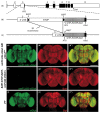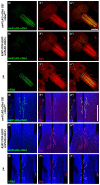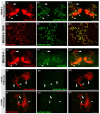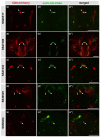A conditional glutamatergic synaptic vesicle marker for Drosophila
- PMID: 35100385
- PMCID: PMC8895992
- DOI: 10.1093/g3journal/jkab453
A conditional glutamatergic synaptic vesicle marker for Drosophila
Abstract
Glutamate is a principal neurotransmitter used extensively by the nervous systems of all vertebrate and invertebrate animals. It is primarily an excitatory neurotransmitter that has been implicated in nervous system development, as well as a myriad of brain functions from the simple transmission of information between neurons to more complex aspects of nervous system function including synaptic plasticity, learning, and memory. Identification of glutamatergic neurons and their sites of glutamate release are thus essential for understanding the mechanisms of neural circuit function and how information is processed to generate behavior. Here, we describe and characterize smFLAG-vGlut, a conditional marker of glutamatergic synaptic vesicles for the Drosophila model system. smFLAG-vGlut is validated for functionality, conditional expression, and specificity for glutamatergic neurons and synaptic vesicles. The utility of smFLAG-vGlut is demonstrated by glutamatergic neurotransmitter phenotyping of 26 different central complex neuron types of which nine were established to be glutamatergic. This illumination of glutamate neurotransmitter usage will enhance the modeling of central complex neural circuitry and thereby our understanding of information processing by this region of the fly brain. The use of smFLAG for glutamatergic neurotransmitter phenotyping and identification of glutamate release sites can be extended to any Drosophila neuron(s) represented by a binary transcription system driver.
Keywords: Drosophila; epitope tag; glutamatergic; synaptic vesicle; vGlut.
© The Author(s) 2022. Published by Oxford University Press on behalf of Genetics Society of America.
Figures





Similar articles
-
A conditional GABAergic synaptic vesicle marker for Drosophila.J Neurosci Methods. 2022 Apr 15;372:109540. doi: 10.1016/j.jneumeth.2022.109540. Epub 2022 Feb 24. J Neurosci Methods. 2022. PMID: 35219770 Free PMC article.
-
Synaptic vesicle protein trafficking at the glutamate synapse.Neuroscience. 2009 Jan 12;158(1):189-203. doi: 10.1016/j.neuroscience.2008.03.029. Epub 2008 Mar 22. Neuroscience. 2009. PMID: 18472224 Free PMC article. Review.
-
Glutamatergic networks in the Ciona intestinalis larva.J Comp Neurol. 2008 May 10;508(2):249-63. doi: 10.1002/cne.21678. J Comp Neurol. 2008. PMID: 18314906
-
VGLUTs: 'exciting' times for glutamatergic research?Neurosci Res. 2006 Aug;55(4):343-51. doi: 10.1016/j.neures.2006.04.016. Epub 2006 Jun 9. Neurosci Res. 2006. PMID: 16765470 Review.
-
Opponent vesicular transporters regulate the strength of glutamatergic neurotransmission in a C. elegans sensory circuit.Nat Commun. 2021 Nov 3;12(1):6334. doi: 10.1038/s41467-021-26575-3. Nat Commun. 2021. PMID: 34732711 Free PMC article.
Cited by
-
Genetic regulation of central synapse formation and organization in Drosophila melanogaster.Genetics. 2022 Jul 4;221(3):iyac078. doi: 10.1093/genetics/iyac078. Genetics. 2022. PMID: 35652253 Free PMC article. Review.
-
A conditional strategy for cell-type-specific labeling of endogenous excitatory synapses in Drosophila.Cell Rep Methods. 2023 May 11;3(5):100477. doi: 10.1016/j.crmeth.2023.100477. eCollection 2023 May 22. Cell Rep Methods. 2023. PMID: 37323572 Free PMC article.
-
Multimerized epitope tags for high-sensitivity protein detection.G3 (Bethesda). 2025 Jun 4;15(6):jkaf070. doi: 10.1093/g3journal/jkaf070. G3 (Bethesda). 2025. PMID: 40191928 Free PMC article.
-
Constitutive and Conditional Epitope Tagging of Endogenous G-Protein-Coupled Receptors in Drosophila.J Neurosci. 2024 Aug 14;44(33):e2377232024. doi: 10.1523/JNEUROSCI.2377-23.2024. J Neurosci. 2024. PMID: 38937100 Free PMC article.
-
SynLight: a dicistronic strategy for simultaneous active zone and cell labeling in the Drosophila nervous system.bioRxiv [Preprint]. 2023 Jul 17:2023.07.17.549367. doi: 10.1101/2023.07.17.549367. bioRxiv. 2023. Update in: G3 (Bethesda). 2023 Nov 1;13(11):jkad221. doi: 10.1093/g3journal/jkad221. PMID: 37502901 Free PMC article. Updated. Preprint.
References
-
- Adams MD, Celniker SE, Holt RA, Evans CA, Gocayne JD, Amanatides PG, Scherer SE, Li PW, Hoskins RA, Galle RF, et al.The genome sequence of Drosophila melanogaster. Science. 2000;287:2185–2195. - PubMed
-
- Baker DA, Beckingham KM, Armstrong JD.. Functional dissection of the neural substrates for gravitaxic maze behavior in Drosophila melanogaster. J Comp Neurol. 2007;501(5):756–764. - PubMed
Publication types
MeSH terms
Substances
Grants and funding
LinkOut - more resources
Full Text Sources
Molecular Biology Databases
Research Materials
